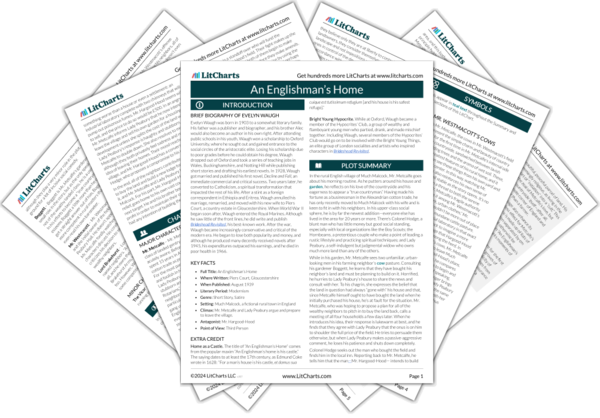In “An Englishman’s Home,” gardens symbolize the gentry’s relationship and history with their land. All of the neighbors in Much Malcock have some sort of garden (even the Hornbeams grow herbs), but Lady Peabury’s is the most lush and abundant of all. This is no coincidence. Lady Peabury, an aging widow and member of the nobility, has lived on her land for a long time. Thus, her gardens are also larger than everyone else’s, a reflection of her family’s generational wealth. While her gardens sprawl with fragrant lime trees and aubretias, Mr. Metcalfe struggles to even sow grass in his. As a relative newcomer, he has yet to truly put down roots in the area, and this bothers him and makes him insecure. The same principle holds in Part IV of the story, in which just as Mr. Metcalfe reflects on the cows, Lady Peabury reflects on her gardens. In just a sentence, Waugh makes the comparison between social and financial stability and the garden: “She was too old now to begin another garden, to make other friends. She would move, like so many of her contemporaries, from hotel to hotel […].” This is what’s at stake for Lady Peabury: not just her lily pond and lead flamingoes, but the time, effort, and security that they signify. In Part V, it turns out to also be what’s at stake for the Hargood-Hoods. They conned the people of Much Malcock in order to maintain their own gardens, which are in fact finer and more established than those of any other character in the story. In this way, gardens themselves come to represent financial stability, generational wealth, and legacy.
Gardens Quotes in An Englishman’s Home
For Metcalfe was but lately initiated into the cult of the countryside, and any features of it still claimed his devotion—its agricultural processes, its social structure, its vocabulary, its recreations; the aspect of it, glittering now under the cool May sunshine, fruit trees in flower, chestnut in full leaf, the ash budding; the sound and smell of it—Mr. Westmacott calling his cows at dawn, the scent of wet earth and Boggett splashing clumsily among the wall-flowers; the heart of it—or what Mr. Metcalfe took to be its heart—pulsing all round him; his own heart beating time, for was he not part of it, a true countryman, a landowner?
Lady Peabury lived at Much Malcock House, whose chimneys, soon to be hidden in the full foliage of summer, could still be seen among its budding limes on the opposite slope of the valley[…]. She was a widow and, like Mr. Metcalfe, had come to Much Malcock from abroad.
The great shadows of the cedars lay across the lawn; they had scarcely altered during her long tenancy, but the box hedge had been of her planting; it was she who had planned the lily pond and glorified it with lead flamingoes […] the flowering shrubs were hers; she could not take them with her where she was going. Where? She was too old now to begin another garden, to make other friends. She would move, like so many of her contemporaries, from hotel to hotel […].
They drove to Mr. Hargood-Hood’s home, a double quadrangle of mellow brick that was famous far beyond the county. On the days when the gardens were open to the public, record crowds came to admire the topiary work, yews and boxes of prodigious size and fantastic shape which gave perpetual employment to three gardeners. Mr. Hargood-Hood’s ancestors had built the house and planted the gardens[...]. A sterner age demanded more strenuous efforts for their preservation.












